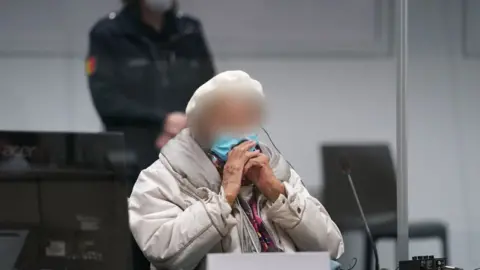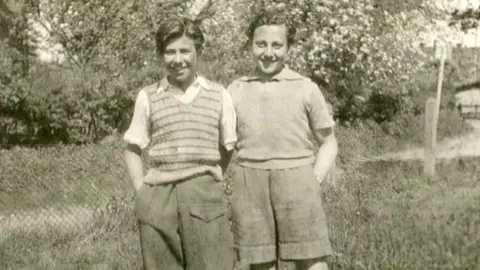Stutthof survivor: Entering Nazi camp meant a death sentence
 Getty Images
Getty ImagesManfred Goldberg was 13 when he was sent to Stutthof concentration camp near the coast of the Baltic Sea in August 1943.
That same summer, Irmgard Furchner had begun working in the camp commander's headquarters as a shorthand typist. Now 97, she has been found guilty of aiding and abetting the murders of more than 10,500 detainees.
It was in 1943 that Stutthof's population of detainees was dramatically enlarged, from a capacity of 4,000 to 25,000.
Most of the original detainees were local Poles and Jews when Stutthof was built in 1939 as the first Nazi camp outside Germany's borders in World War Two. The camp is east of modern-day Gdansk and a short walk from the sea.
By the end of the war at least 110,000 were deported there, including Jewish detainees and Soviet prisoners of war. Some 65,000 of them died as victims of the Nazis, by starvation, typhoid, lethal injection or gas.
"The main entrance gate of Stutthof became known as the Death Gate because once you entered it was more or less a death sentence," Mr Goldberg remembers.
"It was a practical impossibility that [Furchner] could make her way into the camp from her home without knowing what was going on there."
 Getty Images
Getty ImagesGas chambers had been in operation in Nazi death camps since 1942 in German-occupied Poland but it was not until June 1944 that Zyklon B gas was used at Stutthof.
As a Jewish boy from Germany, the young Goldberg had already been deported to Latvia before being sent to Stutthof for slave labour. Now 92, he vividly remembers the five camps and sub-camps of Stutthof that he was sent to.
"I was first in Stutthof in August '43 for close to a month and then two other [camps] before I returned at the end of 1944 for a second time," he told the BBC.
Although young, he remembers becoming part of an indispensable group of 300 prisoners who spent a year repairing railway tracks at junctions blown up by Allied forces. It was during this time as a slave labourer that he met lifelong friend Zigi Shipper.
The only survivor who gave evidence in person to the Furchner trial, Josef Salomonovic, described it as the worst of eight concentration camps he was forced to endure.
American survivor Asia Shindelman, who testified via video link, said she had been taken there with her parents, uncle and grandmother and witnessed prisoners being thrown by guards into electrified fences.
As Soviet forces closed in on Stutthof in late April 1945, the Nazis decided to abandon the camp and sent the remaining inmates on a death march. Such marches became common, as the Nazis sought to erase evidence of their crimes, and many of the detainees were killed as the war neared its end.
"Our group was marched out of Stutthof on 26 April. Anyone marching who didn't have the strength was shot," said Mr Goldberg. He remembers searching for his mother, who had been in the women's camp at Stutthof, when he came across his friend Zigi.
 Holocaust Educational Trust
Holocaust Educational TrustDetainees had to walk the long distance towards Germany as the Nazi Eastern Front crumbled.
Asia Shindelman said many prisoners had to walk hundreds of kilometres with little clothing for the cold weather.
Several thousand prisoners were directed towards the nearby Baltic coast and hundreds were forced into the sea and shot.
Manfred Goldberg's younger brother Herman was murdered by the Nazis but Manfred was eventually reunited with his mother, who was also at Stutthof, and later his father too in the UK.
It was not until 2017 that he returned to Stutthof as part of a visit by the Prince and Princess of Wales and discovered to his surprise that the camp's gas chambers were still intact.
"I was told by the museum that the Nazis laid explosives around the buildings and set them on a timer to explode after they had evacuated, but the timer malfunctioned."
